The aim of this essay is to discuss the notion that the representation of female oppression in literature transcends cultural differences by looking at The Bell Jar and A Thousand Splendid Suns. In order to discuss this notion I researched background information about the representation of female oppression in literature and the different cultures represented in the texts. The essay focuses on female sexuality and the position of women in relationships as indicators for oppression in society. In order to further compare the differences in the nature of the oppression of women, other works and literary critics have been considered. Furthermore the use of literary techniques such as stylistic devices and symbolism has been examined to trace connections between the works.
The conclusion that was found was that both, The Bell Jar and
A Thousand Splendid Suns comment on female oppression in their cultures. The different ways of discussing and presenting the oppression were found to be due to the different contexts of composition.
Inhaltsverzeichnis (Table of Contents)
- INTRODUCTION
- MAIN BODY
- Cultural Differences are often seen as a rationale for oppressive behaviour towards women
- In order to analyse the oppression of females in literature one has to distinguish between mental and physical oppression
- Due to changing political conflicts throughout A Thousand Splendid Sun’s temporal narrative, the female characters are forced to behave as they are told
- Social class is a theme that is important in the beginning of A Thousand Splendid Suns.
- Forced marriages are a common way to oppress women and to remove women from society
- The fear of the oppression marriage may bring is something that is central to Esther’s conflict in The Bell Jar
- During the post war years of the 1950s there was an emerging movement of emancipation and the fight for gender equality
- Looking at A Thousand Splendid Suns and The Bell Jar from a non-contextual viewpoint it becomes apparent that both discuss female oppression
- CONCLUSION
Zielsetzung und Themenschwerpunkte (Objectives and Key Themes)
This essay aims to analyse the portrayal of female oppression in two novels, Sylvia Plath’s The Bell Jar and Khaled Hosseini’s A Thousand Splendid Suns. It seeks to examine how the representation of female oppression transcends cultural differences, despite the different socio-cultural and political contexts of the novels.- The Representation of Female Oppression in Literature
- Cultural Differences in Female Oppression
- Mental and Physical Oppression of Women
- Social Class and Gender Inequality
- The Role of Marriage in Female Oppression
Zusammenfassung der Kapitel (Chapter Summaries)
The essay begins by introducing the concept of female oppression and arguing that it is a prevalent issue even in seemingly progressive societies like 1950s America. This is illustrated through the experience of Esther, the protagonist of The Bell Jar, who struggles with societal expectations and mental anguish.
The essay then contrasts Esther's situation with the experiences of Mariam and Laila, the female protagonists of A Thousand Splendid Suns, who face severe forms of physical and social oppression under the Taliban regime in Afghanistan. The essay examines how different cultural contexts shape the forms of oppression women face, but also argues that the underlying causes are often rooted in patriarchal systems and societal norms that perpetuate gender inequality.
The essay further explores the theme of social class, highlighting how Mariam's status as a “harami” (bastard child) puts her at the bottom of Afghan society and subjects her to discrimination and marginalization. The essay also examines the detrimental effects of forced marriages, particularly in the case of Mariam and Laila, who are forced into marriages with the abusive Rasheed.
The essay concludes by comparing Esther’s struggles with the experiences of Mariam and Laila, highlighting the universality of female oppression across different cultures and societal contexts. It argues that despite differences in how oppression manifests, women are often denied the freedom of self-determination and are subject to patriarchal systems that restrict their choices and opportunities.
Schlüsselwörter (Keywords)
The main keywords of the essay are female oppression, cultural differences, mental and physical oppression, social class, gender inequality, marriage, freedom, self-determination, The Bell Jar, A Thousand Splendid Suns, Sylvia Plath, Khaled Hosseini, Afghanistan, America, 1950s. The essay explores how these themes intersect and contribute to the broader understanding of female oppression in literature.- Quote paper
- Florian Kollmeier (Author), 2013, Female Oppression in "The Bell Jar" and "A Thousand Splendid Suns", Munich, GRIN Verlag, https://www.grin.com/document/215425



